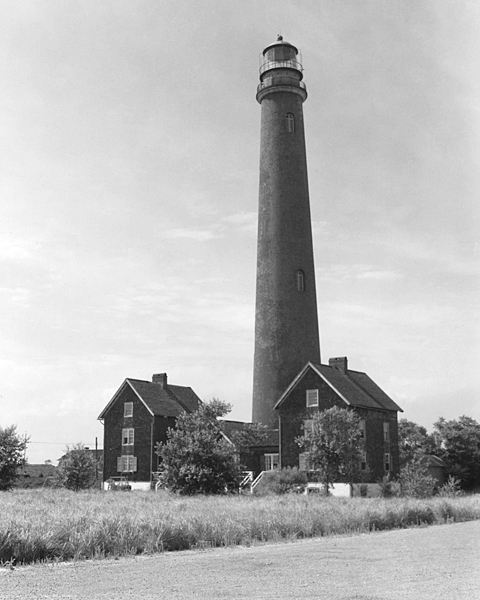The Shinnecock Bay Lighthouse was once part of the tallest lighthouses on the Eastern Seaboard. It filled the void between Montauk Point and Fire Island. It was located at Ponogue Point, on the northerly side of the Shinnecock Bay.
It was built in 1857 and deactivated in 1931. The lighthouse was made of red brick and had a drab dwelling attached to it. It towered 170 feet over Ponquogue Point, and if it were standing today, would be considered one of the tallest standing lighthouses in the U.S.
The lighthouse was 168 feet tall and lit using a 1st order Fresnel lens that stood 12 feet by itself. This was in 1858. In 1931 it was decommissioned.

In 1948 it was demolished and replaced with a skeleton tower. Later, the Coast Guard replaced that with a communication tower and the light was heightened to 75 feet. After the creation of the lighthouse board, letters were sent to captains of ships traveling between the U.S. and Europe to find their output on the quality of the lights of the U.S. compared to other nations, and to see where new lights may be needed. Commander of the packet-ship: Wisconsin, C.R. Mumford wrote a letter in September 1851:
“Within the last few years, a great number of vessels have been stranded between Montauk Point light, and Fire Island; and in many instances there has been a great loss of life, as many of them were vessels loaded with emigrants; and I would most respectfully suggest that a powerful flashing light be placed on some elevated position about halfway between Montauk and Fire Island lights. This last light is but a very indifferent one, and at a distance of ten miles, shows about as large as a star of the fourth or fifth magnitude.”
On August 3rd, 1854, Congress provided $35,000 to create a lighthouse to be situated at Great West Bay, also known as Shinnecock Bay, and also $12,000 to complete the construction. This was on August 18th, 1856.
The Shinnecock Bay Lighthouse was turned on in 1858. It lit up a 67 mile dark void between Montauk Point Lighthouse and the Fire Island Lighthouse.
The money was used to buy ten and a quarter acres of land near the Great West Bay. The area was purchased from John Foster and Edward Foster for $1,200 with the agreement that the purchase would grant both men the exclusive right to gather and use the seaweed coming from the beach, east of the property. The station was considered to be built on the barrier beach, south side.
The construction was overseen by Lieutenant J.C. Duane and James St. Clair Morton of the Engineer Corps. The digging was a 10-foot hole. Pine logs in a perpendicular pattern were created and filled with concrete. Granite blocks were set at the base and about 800,000 bricks were used to build the tower part. A large iron column was used for the staircase for support and ran down the center of the tower.
Two, two-and-a-half-story buildings had also been built for the keepers of the lighthouse. The one in charge received a $ 500-a-year salary and was given to Charles A Conley.
In 1893 the original name of the lighthouse was changed to Shinnecock Bay, and in 1901 the lighthouse board requested funds to change the light’s characteristic from being a fixed light to a flashing one. The reason being that a lot of transatlantic steamers mistook the light to be of another ship’s and was confusing. The funding took place in 1907.
Incandescent oil vapor was used and tripled the candlepower. In 1915 a lens with bull’s eye panels, along with brass panels were installed.The light pattern changed to a group of three white flashers
There was a hurricane in 1938. It did not result in damage to the brick lighthouse, but it destroyed a metal tower. In 1939, another tower was built. It stands today. In 1934, the Federal Government offered the town of Southampton to lease the lighthouse, but the board of the town rejected it. In 1939 the Coast Guard took over the lighthouse and felt it was unstable and felt it should be torn down, but the residents of the town wanted to preserve it. The Coastguard had other plans, and in 1948 they chiseled away at the base of the tower and replaced it with timbers that would be burned to tilt the tower over.
